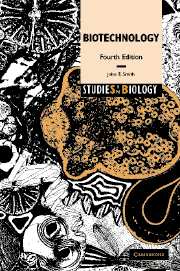Book contents
- Frontmatter
- Contents
- Preface
- 1 The nature of biotechnology
- 2 Substrates for biotechnology
- 3 Genetics and biotechnology
- 4 Bioprocess/fermentation technology
- 5 Enzyme technology
- 6 Biological fuel generation
- 7 Single cell protein (SCP)
- 8 Biotechnology and medicine
- 9 Environmental biotechnology
- 10 Biotechnology in the agricultural and forestry industries
- 11 Food and beverage biotechnology
- 12 Protection of biotechnological inventions
- 13 Safety in biotechnology
- 14 Public perception of biotechnology: genetic engineering – safety, social, moral and ethical considerations
- 15 Looking to the future
- Glossary
- Further reading
- Index
2 - Substrates for biotechnology
Published online by Cambridge University Press: 05 June 2012
- Frontmatter
- Contents
- Preface
- 1 The nature of biotechnology
- 2 Substrates for biotechnology
- 3 Genetics and biotechnology
- 4 Bioprocess/fermentation technology
- 5 Enzyme technology
- 6 Biological fuel generation
- 7 Single cell protein (SCP)
- 8 Biotechnology and medicine
- 9 Environmental biotechnology
- 10 Biotechnology in the agricultural and forestry industries
- 11 Food and beverage biotechnology
- 12 Protection of biotechnological inventions
- 13 Safety in biotechnology
- 14 Public perception of biotechnology: genetic engineering – safety, social, moral and ethical considerations
- 15 Looking to the future
- Glossary
- Further reading
- Index
Summary
A biomass strategy
It has been estimated that the annual net yield of plant biomass arising from photosynthesis is at least 120 billion tonnes of dry matter on land and about 50 billion tonnes from the world's oceans. Of the land-produced biomass, approximately 50% occurs in the complex form of lignocellulose.
The highest proportion of land-based biomass (44%) is produced as forest (Table 2.1). It is surprising to note that while agricultural crops account for only 6% of the primary photosynthetic productivity, from this amount is derived a major portion of food for humans and animals as well as many essential structural materials, textiles and paper products (Table 2.2). Many traditional agricultural products may well be further exploited with the increasing awareness of biotechnology. In particular, new technological approaches will undoubtedly be able to utilise the large volume of waste material from conventional food processing that presently finds little use.
Biomass agriculture, aquaculture and forestry may hold great economic potential for many national economies, particularly in tropical and subtropical regions (Fig. 2.1). Indeed, the development of biotechnological processes in developing areas where plant growth excels could well bring about a change in the balance of economic power. world has drawn heavily on fossil fuels that took millions of years to form beneath the beds of the oceans or in the depths of the earth. Furthermore, it is a very unequal pattern of usage.
- Type
- Chapter
- Information
- Biotechnology , pp. 21 - 32Publisher: Cambridge University PressPrint publication year: 2004
- 2
- Cited by



